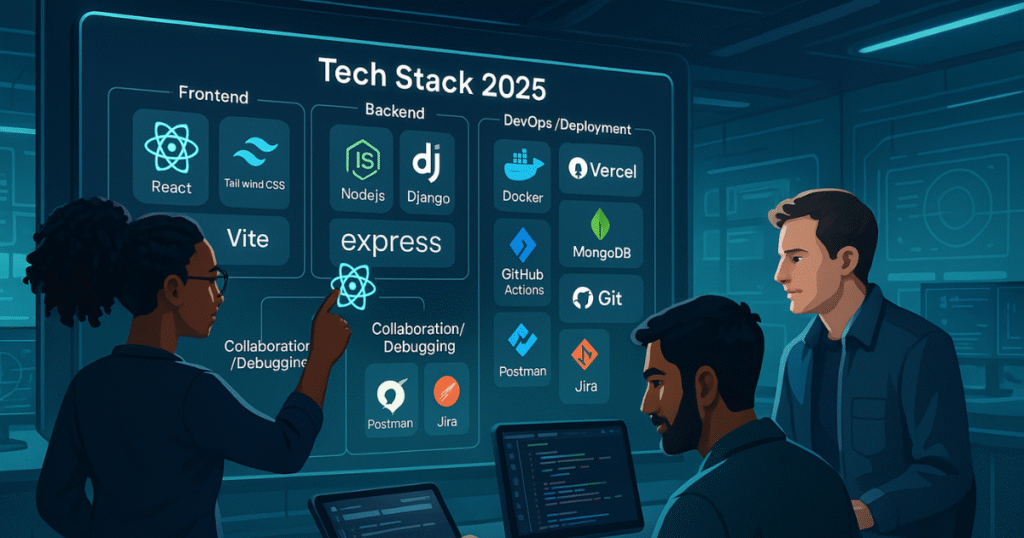Exclusive digital marketing services, 100% Satisfaction, and Money Back Guarantee! Learn More
In today’s competitive development landscape, choosing the right tools is critical to full-stack success. As tech stack evolution accelerates in 2025, developers must continuously refine their toolchain to keep pace with modern demands. Full-stack development tools are no longer optional, they’re essential for streamlining workflows, ensuring consistency, and maximizing developer productivity. Whether you’re building single-page apps or large-scale web platforms, mastering the right tools means better performance, faster delivery, and cleaner code. This guide explores the must-know tools that are redefining full-stack development this year.
Version Control with Git and GitHub
Version control with Git and GitHub is the backbone of any collaborative development process. Git allows developers to track changes, manage commit history, and implement sophisticated branching strategies. GitHub enhances these capabilities by supporting open-source collaboration, pull request workflows, and integrated CI/CD. In 2025, tools like GitHub Copilot and Codespaces are streamlining development by offering AI-powered coding suggestions and cloud-based dev environments. Together, Git and GitHub provide a reliable, scalable version control system vital for every full-stack developer.
Frontend Frameworks – React, Vue, and Beyond
Frontend frameworks like React or Vue remain essential for crafting dynamic and responsive UIs. With a component-based architecture and advanced state management solutions like Redux or Pinia, these tools help developers build scalable, maintainable front-end experiences. React’s ecosystem, including Next.js, continues to dominate in 2025, while Vue’s simplicity and performance improvements gain traction. These frameworks enhance responsive UI design and ensure seamless cross-device performance. Frontend proficiency also plays a pivotal role in delivering custom website development services tailored to client needs.
Backend Technologies for 2025 Projects
Backend technologies like Node.js and Django power the server-side logic behind every robust application. Node.js excels in asynchronous programming, making it ideal for real-time features like chat apps or streaming services. Django, on the other hand, is a high-level Python framework offering built-in middleware, admin interfaces, and security features. Both are instrumental in building RESTful APIs and managing scalable backend systems. In 2025, choosing between them often depends on project needs, tech stack familiarity, and community support.
Mastering API Testing – Postman and Swagger
API testing tools (Postman, Swagger) ensure reliable communication between frontend and backend components. Postman is popular for endpoint validation, testing automation, and environment simulation. Swagger, often paired with OpenAPI, allows developers to document, test, and share APIs through a visual interface. These tools improve JSON schema verification, boost developer collaboration, and reduce integration bugs. Mastering them is essential for full-stack developers working on microservices, third-party APIs, or internal RESTful architectures.
CI/CD – Streamlining Development and Deployment
Continuous integration and deployment (CI/CD) pipelines are vital for modern development. Tools like GitHub Actions and Jenkins automate the build-test-deploy process, ensuring code quality and rapid releases. Developers can create pipeline automation for testing, linting, containerization, and deployment workflows. In a typical lifecycle, code pushed to GitHub triggers tests, builds containers, and deploys to production within minutes. This efficiency supports DevOps culture and allows full-stack teams to deliver updates with confidence and speed.
Containerization and Virtual Environments
Containerization with Docker has become standard for managing consistent environments across development, testing, and production. Docker Compose allows developers to spin up multi-container apps with ease, while Kubernetes takes it further with microservices architecture orchestration. Virtual containers provide flexibility for teams offering custom website development services that demand scalable, reproducible setups. In 2025, Docker’s role in CI/CD, cloud-native development, and hybrid cloud deployment is more prominent than ever.
Managing Databases Efficiently
Database management tools (MongoDB, MySQL, PostgreSQL) remain essential for storing and retrieving application data. MongoDB supports NoSQL structures, ideal for unstructured or rapidly changing data, while MySQL and PostgreSQL offer robust SQL options for structured queries. Query optimization, indexing strategies, and the use of ORMs like Sequelize or Prisma enhance performance and maintainability. In full-stack projects, effective database management supports everything from data integrity to analytics.
Developer Productivity – Editors, IDEs, and Debugging
Developer productivity often hinges on choosing the right code editors and IDEs for developers. Visual Studio Code dominates in flexibility and plugin support, while WebStorm appeals to those seeking a more specialized JavaScript IDE. Monitoring and debugging tools like Chrome DevTools, LogRocket, and Sentry assist with live debugging, setting breakpoints, tracking performance, and logging errors. These tools are vital for catching bugs early and ensuring a seamless user experience throughout development.
Conclusion
In full-stack development, having the right tools isn’t just a matter of preference; it defines your workflow efficiency and project success. From containerization with Docker to robust backend frameworks and advanced debugging tools, the modern developer’s toolkit must be powerful and adaptable. Using the right tools not only boosts efficiency but also improves quality, especially for teams offering professional website development services. As tech evolves, so should your stack. Make 2025 the year you invest in the tools that elevate your development game.
